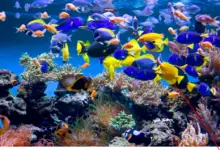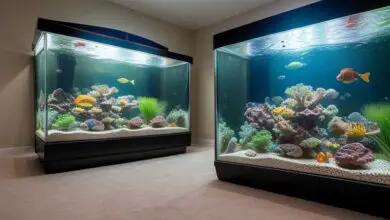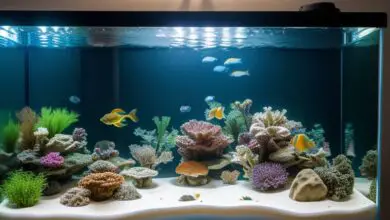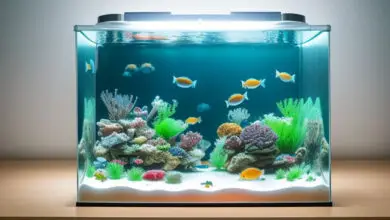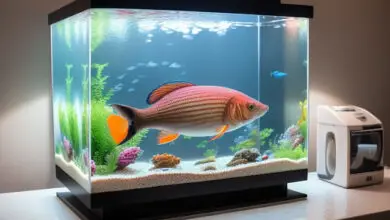Choosing Eco-Friendly Aquarium Substrates

Setting up an aquarium involves making many decisions that can impact the health of your fish and underwater environment. An often overlooked but very important choice is what type of substrate to use on the floor of the tank.
Substrate refers to the material that covers the bottom section of the aquarium. It serves decorative purposes but also provides critical filtration and beneficial bacteria that keep your tank ecologically balanced.
Traditional substrates like brightly colored gravel may look nice but can pollute water and harm fish. More natural options are gentler for tank inhabitants while better supporting the living ecosystem of the aquarium.
This guide explains why substrate matters,evaluates common aquarium substrateoptions, and offers eco-friendly recommendations for keeping a sustainable tank.
Why Substrate Selection Matters
Choosing the right substrate establishes a solid foundation for the health of the entire aquarium. Benefits of an appropriate bottom layer include:
Filtration
Substrates filter toxins and waste from the water column. Small particles and porous surfaces harbor beneficial bacteria that continuously break down fish waste and leftover food. This nitrifying bacteria keeps ammonia and nitrites in check while producing nitrates for plants to absorb.
pH Buffer
Mineral-rich substrates can stabilize pH at healthy levels for tank inhabitants. They prevent wide pH swings that stress fish.
Natural Look
An aesthetically pleasing substrate complements your aquascape and gives fish a comfortable terrain similar to their wild habitats. The right colors and grains provide natural beauty and contrast to aquarium plants and decor.
Burrowing/Foraging
Some fish and invertebrates naturally sift through substrate looking food and particles to eat. Fine sands support these burrowing species.
Plant Growth
Plant-based aquariums rely heavily on substrate for healthy root development and propagation. Nutrient-rich plant substrates have become very popular.
Considering the wide impact of aquarium substrates, choosing sustainable options is an easy way to implement eco-friendly tank practices.
Problems With Common Aquarium Gravels
For decades brightly colored gravels have been popular choices to line aquarium floors. However many standard aquarium gravel options have significant downsides.
Unnatural Appearance
The neon paints that color traditional aquarium gravel are quite unnatural. Bright pink, green, and purple substrates hardly mimic most fishs’ native environments. These bold hues may please our human eyes but do not appropriately welcome most aquatic species.
Jagged Edges
Rough, jagged gravel can scrape the sensitive undersides of burrowing species like cory catfish. So smooth round grains are preferable for tanks with bottom dwellers.
Minimal Bacteria Growth
Common aquarium gravels do not offer ideal texture or surface area to grow beneficial filter bacteria. Their perfectly round, non-porous pebbles limit the nitrifying colonies that develop. So more waste accumulates in the water column rather than getting broken down.
This strains filtration units and requires more frequent water changes. Replacing 25-50% of aquarium water weekly removes some waste but also destroys delicate biofiltration bacteria growing on substrates and tank surfaces. Frequent 100% water changes crash entire nitrifying colonies.
Eco-conscious keepers aim to limit water use and nutrient pollution from aquarium discharges. So gravel’s lack of biofiltration directly conflicts with sustainable aquarium goals.
Various Pollutants
Standard gravel substrates have raised health concerns due to manufacturing pollutants and toxins:
- Paint flecks – Bright paint on aquarium gravel contains metals like copper that leach toxins into the water column. Fish ingest toxins both through their gills and when mouthing substrates.
- Heavy metals – Gravels sourced from industrial mining operations may contain heavy metal contaminants like zinc, cadmium, lead, and arsenic. These harm fish gills, inhibit enzyme function, attack organs, and impact egg/fry development.
- Formaldehyde – Some colored gravels are pretreated with the carcinogenic preservative formaldehyde to prevent mold growth before aquarium use. Rinsing helps leech some out but does not eliminate the health hazard it poses.
So despite their widespread availability and low cost, traditional aquarium gravel poses multiple ecological issues in home aquariums. Thankfully a variety of healthier, more sustainable substrates now exist.
Evaluating Eco-Friendly Substrate Alternatives
Recent years have brought growing awareness of aquariums’ environmental impact. Sustainability extends not just to ethically sourced livestock but also to ancillary products that equip home tanks.
Following factors help evaluate whether substrates qualify as eco-friendly:
Natural composition – Made from renewable raw materials like recycled glass, sustainable forestry products, volcanic soil minerals, etc. Some even upcycle waste material from other industries.
Biodegradable – Ability to slowly break down through natural processes without leaving permanent synthetic residues behind. Allows re-introduction to environmental nutrient cycles rather than landfill contamination.
Non-toxic – Free from paints, chemical coatings, preservatives, pesticides and other synthetic additives. Safe for aquatic life forms and home disposal/repurposing.
Ethical resourcing – Environmentally and socially responsible sourcing that ensures fair labor practices and stewardship of mining locations.
Energy efficient manufacturing – Production methods actively work to limit environmental harms through energy, waste and pollution reduction.
Locally available – Regional availability cuts back on transport miles and supports local aquarist communities.
Affordably priced – Wider cost affordability allows product adoption enabling more eco-friendly tank keeping practices.
With these sustainability criteria in mind, let’s survey some substrate options available to mindful aquarists.
Top Eco-Friendly Substrate Contenders
Many promising alternatives to standard aquarium gravels now exist:
Sand
All-natural sand makes a great default substrate option with several pros:
Prevalent in nature – Familiar terrain for many commonly kept tropical fish species. Mimics natural habitats.
Gentle – Softer on sensitive barbels and burrowing species. Less likely to abrade undersides than jagged gravel.
Versatile – Suitable for a wide variety of tropical, coldwater and marine setups. Can be mixed with other substrates.
Affordable – Inexpensive, especially when sourced locally or reused. Play sand costs a few dollars for hundreds of pounds. Some reef keepers reuse crushed coral.
Customizable – Available in spectrum of earth tone colors through iron oxide natural dyes. No unnatural neon hues.
Biodegradable – Silica based thus fully recyclable back into nature.
Downsides of sand primarily relate to its fine grains compacting tightly:
- Can compress anaerobic gas pockets harmful to plant roots and burrowing fish unless stirred. Adding Malaysian trumpet snails helps prevent.
- Needs gentle cleaning by siphoning or stirring top layers to prevent buildup of decomposing waste tainting water over time.
- May need rinsing before adding if very dusty when dry.
Despite these manageable cons, sand remains a recommended eco-budget substrate for aquariums, especially pairing with hearty plants and burrowing creatures. Mine locally or reuse clean play sand for ultimate sustainability.
Soil/Potting Mix
High quality potting mixes work wonderfully to cultivate heavily planted tanks:
Nutrient-rich – Nourishes root feeder plants better than mineral substrates lacking organic compounds. Supports lush growth.
Natural appearance – Dark earthy colors and varied textures look attractive while mimicking terrestrial growing conditions.
Moderates pH – Contains peat and humus compounds that gently buffer water pH down closer to wild stream parameters.
Economical – One bag of organic potting soil goes a long ways covering a tank bottom. Cheaper than commercial aquarium plant substrates.
Biodegradable – Made from renewable plantation pine bark, coco coir, composts and sustainable forestry products. Recyclable.
Reduces waste – Grows plants quickly helping consume fish excretions like ammonia and nitrates. Lesser water quality worries.
Potential cautions with potting mix:
- Can initially leech some ammonia during submerged mineralization period as organics adjust from terrestrial to aquatic breakdown. This settles over 2-4 weeks.
- Some cheaper brands may surreptitiously contain synthetic slow release fertilizers inappropriate for indoor aquarium use unless verified absent. Stick to 100% natural organic bags.
- Lightweight particles might need gentle placement layered below 1” of sand or gravel to prevent clouds or accidental tank aspiration if aggressively uprooted later.
Assuming a quality mix free of chemical fertilizers, sustainable potting soils offer planted tanks a safe, effective growth substrate while minimizing overall environmental impact. An easy eco-friendly choice.
Crushed Lava Rocks
Interesting deep red scoria rock formed as molten lava rapidly cools. Offers unique properties:
Porous and lightweight – High surface area harbors nitrifying bacteria that steadily filter waste products and detoxify.
Chemically inert – The natural igneous mineral composition lacks metals that could dissolve into water. No pH impacting compounds leech either.
Plant anchoring – Jagged edges create perfect nooks and crannies for plant roots to mechanically adhere to. Growth stabilizing.
Decoratively striking – Distinctive reddish cinder appearance stands out boldly against lush greenery and fish. Provides accent color.
Reusable forever – Essentially lasts indefinitely before requiring replacement. Rinse and reuse lava chunks indefinitely across setups or give away.
Affordable availability – As landscaping staple, easily found at most garden stores for low cost. Buy in bulk bags.
Ethically sourced – Volcanic filtration byproduct prevents destructive open pit quarrying solely for aquarist market. Locally produced in some regions further reducing environmental transport impacts.
Not ideal for burrowers – Jagged lava edges may irritatesensitive undersides of catfish and loaches. Best paired with mid or upper tank dwellers.
For planted tanks without bottom burrowers, crushed lava offers incredible biofiltration, striking aesthetics and endless reusability at a bargain ethical cost. A unique sustainable substrate worth trying!
Recycled Glass
Crushed recycled glass substrates gained popularity offering green aquarists attractive eco-benefits:
Sustainable Materials – Made entirely from post-consumer recycled glass diverted from landfills. Turns trash into treasure! Choose colors matching original bottles like green or brown.
Smooth and sturdy – Tumbled glass edges prevent snagging fish while still allowing plant anchoring. Nice appearance too.
Chemically inert – Unlike paints or dyes, crushed glass introduces no toxins or water chemistry alterations.
Good bacteria host – Porous shards enable biofilm growth around crevices and cavities to steadily filter waste metabolites.
Affordable availability – Mass produced at economy of scale and sold through major online/big box retailers
Reusable – Glass itself lasts indefinitely. Rinse and reuse shards long term or donate through Buy Nothing groups when finished.
Hardness buffering – Dissolved glass silicates slowly replenish alkaline minerals consumed by aquarium acidity. Helps maintain pH.
Not the best plant rooter – Lacks high cation exchange capacity clay minerals that many plant species prefer associating roots around. Grow lower maintenance varieties instead.
Eco-centric aquarists seeking predictably smooth substrates safe for fish will appreciate recycled glass shards for their sturdy durable nature and environmentally friendly lifecycle impacts.
Activated Coconut Charcoal
While technically not a substrate itself, activated charcoal makes a beneficial supplement mixed 10-20% into other sediments:
Toxin absorber – Extreme porous surface attracts and sequesters unwanted dissolved organic compounds from water column. Reduces discoloration or odors.
Safeguards medications – Prevents antibiotic overdosing by limiting excess access until doses fully deplete through scheduled water changes. Protects inhabitants.
Purely natural – Starts as renewable coconut shells, undergoes steam activation and kiln drying to produce charcoal powder safe for aquatic life.
Cleans hands easily – Charcoal rinses cleanly off skin unlike some traditional black gravels permanizing stains. No embedded dyes or inks.
Economical – Small ounces or grams needed to mix 10% into whole tank worth of substrate. Buy food or water filter grade only.
Biodegrades safely – Allows safe composting once sorption capacity wears down after a few years. Coconut source replenishes naturally.
Can lower fertilizer – Charcoal adsorption strips some liquid ferts from reaching plant roots. Use root tabs or enriched substrate instead.
While too light alone, activated charcoal makes an excellent occasional addition into other sediments seeking enhanced toxin export and protection for tank inhabitants. Affordable eco-boost.
Evaluating Locally Sourced Substrates
Beyond commercially branded substrates, creative aquarists source or make DIY options from local sustainable sources:
Crushed shells – Seashells from restaurant or seafood supply leftovers provide alkaline buffering and calcium for shelled snails or shrimp. Rinse well first.
Food compost dirt – Nutrient rich organics from gardening neighbors or community gardens offer similar benefits to potting soils. Skip if chemically treated.
Red clay – Rich native clays collected responsibly provide the natural earth found in wild fish habitats. Let dry fully before adding.
River rocks – Tumbled smooth stones from local waterways serve similar functionality as commercial pebbles. Boil or bake first to sanitize.
Upcycled materials – Consider repurposing shreds of sustainable materials destined for landfills. Upcycle cotton, hemp, bamboo, coconut coir, hay, or wood.
Seize opportunities to salvage sustainable scraps for secondary usage as tank substrates. What locally sourced materials might be lurking around your community? Get creative!
Top Eco-Friendly Substrate Picks By Aquarium Type
With so many options to pick from, recommendations help narrow choices by setup type:
Freshwater Planted Aquariums
Best – Organic potting soil mixed with sand cap
Also try – Commercial plant growth substrates
Freshwater Community Aquariums
Best – All natural sand or fine gravel
Also try – Crushed lava rocks, recycled glass
Freshwater Species setups
Best – Match natural species habitats. Sand for burrowers, etc.
Also try – Very smooth gravels and pebbles
Cichlid Tanks
Best – Crushed coral raises hardness they need
Also try – Holey limestone rock rubble, aragonite sand
Saltwater FOWLR
Best – Aragonite, crushed coral for buffers
Also try – Mixed reef salt blends
Saltwater Reef setups
Best – Reef sand mixes, aragonite
Also try – Mixed crushed coral with live sand
Top Tips For Applying New Substrates
Once selecting new sediments, proper application technique ensures a smooth transition:
- Rinse thoroughly – Multiple rinses in batches limit clouding later.
- Layer in phases – Add a little at a time over hours allowing particles to settle. Take breaks allowing any fog to clear up inbetween thin layers.
- Pour slowly – Trickle tiny streams out of buckets from just over the water line. Splashing clouds.
- Angle aim – Change trajectory points around the tank to evenly build slope depth. Level flat for burrowers.
- Depth – Usually 1-3 inches total depth satisfies most setup types depending on stocked species preferences.
- Mix gently – Once settled across the bottom, smooth out tall mounds and pits to unify layers if desired. Stir rather than blow.
- Check clarity before adding livestock – Ensure sediments fully settled and water polished crystal clear again prior to moving inhabitants in.
With some simple finesse and patience, fresh substrates easily transition without mishap. Then enjoy watching plants take off or fish explore new terrain!
Substrate Recycling When Tearing Down Tanks
While great for establishing new setups, eco-friendly substrates also offer sustainable options when dismantling old tanks:
Reuse
For inert products like sands, gravel or lava rocks, rinse clean and directly transfer into new or different aquarium setups indefinitely.
Compost
Soils, potting mixes and plant substrates safely break down replenishing gardens or houseplants. Ensure no medications or chemicals first. Spread thin allowing to fully dry out between uses to prevent mold. May require extended mineralization periods before reverting to aquatic submerged use again.
Discard
If unable to reuse or compost, responsibly bag up sediments avoiding environmental contamination and place in normal household waste collection bins for landfill disposal as a last resort.
Support Further Industry Improvements
Beyond our direct purchase selections as consumers, aquarists collectively nudge the ornamental fisheries industry towards enhanced sustainability through constructive feedback to retailers and wholesalers.
Contact favorite local fish stores or national chains and politely share interest in further expanding offerings of organic, responsibly resourced and eco-friendly products like substrates.
Vote with dollars while using your voice as concerned aquatic hobbyists. Together we gain momentum on issues affecting long term animal and environmental welfare. Make your interests known!
Cultivate Greener Aquarium Keeping Habits
This foray into eco-friendly aquarium substrates touched on just one aspect of cultivating more sustainable home fishkeeping practices and mindsets.
We shape this hobby to steward rather than exploit aquatic life under our brief care. Consider adopting these other aquarium modifications for incremental impact:
-
- House appropriately sized bio loads avoiding animal cramming
- Research animal origins and collection points
- Feed varied omnivore diets with seafood sustainability in mind
- Avoid disposable plastic cartridges and media replacements when possible
- Limit water changes through dense planting and effective filtration
- Seek out energy efficient equipment when upgrading pumps, lights etc
- Design low maintenance setups reducing involvement requirements
- Propagate and share plant clippings rather than continually buying new
- Consider reusable cloth filter media instead of disposable polyfiber
- Opt for stainless, glass or solid wood versus painted or laminated products
- Choose reusable air-driven sponge filters over replaceable cartridges
- Prioritize quality & reparability over trendy yet wasteful disposable goods
- Repurpose, sell or donate old equipment rather than sending to landfills
- Support fellow hobbyists by trading cuttings locally instead of mass producers
- Overall consume consciously while using resources wisely
Our collective small acts cultivate significant positive change over time. Share the hobby responsibly with future generations of aquatic enthusiasts by adopting sustainable mindsets today!
Final Thoughts
Substrate selection plays a foundational role establishing healthy, eco-friendly aquarium ecosystems. Conscientious choices not only benefit our home aquariums but also steward environmental habitats where our livestock originate.
Do some research into sourcing promising sustainable substrates for your particular tank setup needs. Prioritize natural products from reputable stewards.
Pair substrate decisions with other incremental hobby improvements promoting animal wellbeing and environmental stability long term. Our interests indelibly intertwine.

